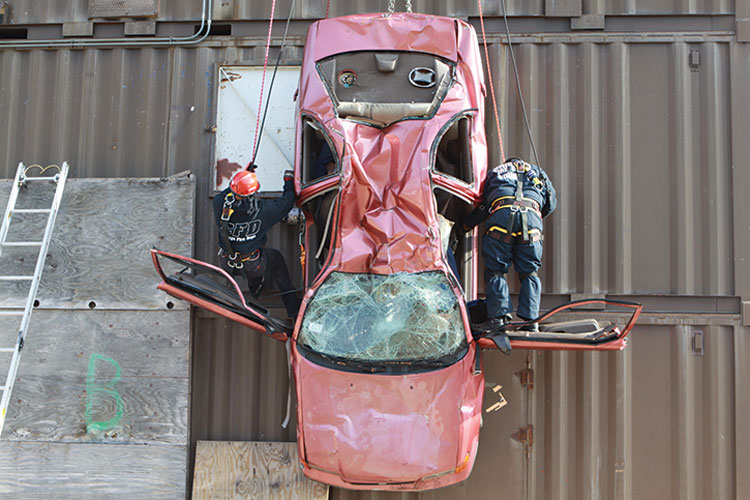
By Michael M. Dugan
Training on a high-risk/low-frequency event is one of the most important kinds of training to conduct for the members of your department. Such a response can prove to be very difficult and dangerous, and operating personnel need to know what to expect. This training is vital for members and officers to understand the risks associated with this type of call. If you are not preparing your members to handle a call like this, you are not preparing them for today’s world of distracted drivers.
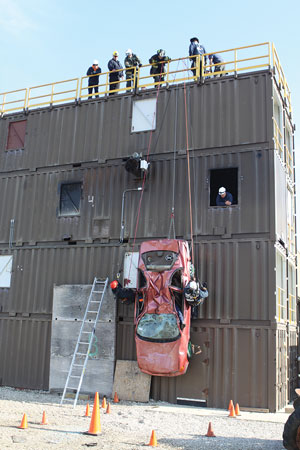 |
| (1) The vehicle is suspended from the training tower. The safety ladder is placed alongside the structure, and the area below the training is cordoned off. (Photos by Tim Olk.) |
Training on a high-risk/low-frequency task is vital for the safety of all members involved. It does not matter what your department’s specialized skills are; your members need to be trained in that skill set. If your company does hazmat, you are going to need hazardous material technicians. If you do high-angle rope rescue as depicted here, you need to be trained and certified as a rope technician. You need ongoing training in these skills, as the tools change and you need to use your skills to keep current. Don’t give your members a course in rope and then two or three years later expect them to perform a high-angle rescue. Train in these skills continuously, and have an annual competency test.
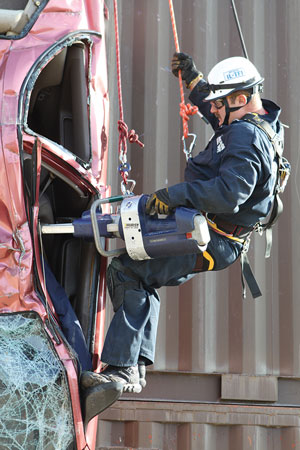 |
| (2) A member uses a tool while the tool and the member are tied off from above. This might give the member an indication of how the tool is going to react. |
Your department’s command staff must understand what the members are capable of and allow them to work to that level of training. These special skills can include hazmat; high angle, dive, and confined space rescue; and any other skill that requires additional training and knowledge.
 |
| (3) A member has used the tool to force open the driver-side door. Now the member can assess the patients and determine what other actions need to be taken inside the vehicle. |
A department responding to an accident like the one depicted here might be able to only stabilize the vehicle and await a trained and equipped team to handle the incident. That’s not always what you want to do; but to protect your personnel, it might be the only viable option.
 |
| (4) Members have forced the driver-side and passenger doors and are now attaching safety lines to the victims. |
These photos are from a scenario in the Vehicle & Machinery Technician class at the Northeastern Illinois Public Safety Training Academy. Members of the Chicago (IL) Fire Department worked to free three victims in a vehicle suspended from a training tower to simulate a parking garage or highway overpass with a wrecked car suspended. The class consisted of 40 hours of combined classroom and practical evolutions. The scenario involved an extrication scenario suspended from the side of a building. The vehicle contained three mannequins that were trapped, one in the rear seat and two in the front seats of a two-door vehicle. The roof was collapsed onto the victims as well.
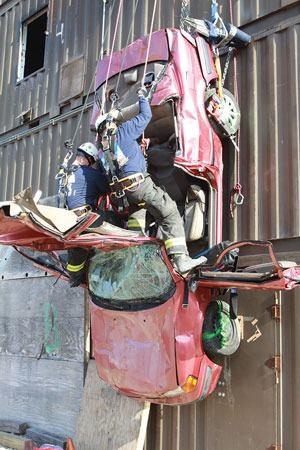 |
| (5) The roof of the vehicle has been folded forward, and the rescuers are working on additional victims located deeper in the vehicle. |
One of the prerequisites for this class was rope rescue training. A group of 10 to 15 students performed the training rescue using modern rope and extrication techniques. An objective was to secure the vehicle from further movement and deploy a system using a grip hoist. The members learned to use the tools and equipment and understand the difficulty while suspended from a rope.
 |
| (6) Members harness the second victim for removal from the vehicle. |
This training, as with all training, is made as safe as possible with the use of safety lines and backup safety systems. Expect some bumps and bruises to occur during this type of training! Although we strive to make training as safe as possible, having members and tools suspended on the side of a building to extricate three victims might result in a few minor injuries. Some might say that no injury is acceptable in training. However, members have to understand how the tools will react and how they will react to the tools while being suspended-before an actual incident.
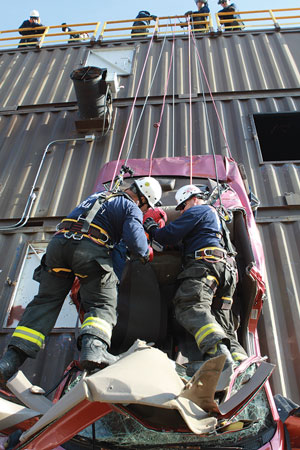 |
| (7) Members remove the final victim from the vehicle. After this training is completed, participants critique the entire operation. |
This training is a safe way to learn what actions work and what actions cause unintended reactions. Our training must reflect what we might be called on to do in the street.
Realistic training provides for realistic evaluation of our equipment, members, and standard operating procedures. Be sure to have the instructors and students critique the training event. Document lessons learned and, more importantly, issues with tools, techniques, and communication; communicate any findings to all individuals who may be required to operate or supervise an operation of this type. We become safer when we train, learn, and share our knowledge.
MICHAEL M. DUGAN, a 40-year veteran of the fire service, was a 27-year member of the Fire Department of New York (FDNY), where he served as captain of Ladder Company 123 in Crown Heights, Brooklyn, before retiring. As a lieutenant, he served in Ladder Company 42 in the South Bronx. While assigned as a firefighter in Ladder Company 43 in Spanish Harlem, he received the James Gordon Bennett medal in 1992 and the Harry M. Archer Medal in 1993, FDNY’s highest award for bravery. He was a volunteer firefighter in Halesite, New York. He lectures on truck company operations, building construction, size-up, and today’s fire service. He is a member of the FDIC and Fire Engineering educational/editorial advisory boards.
Stages of Coordinated Vehicle Rescue
Vehicle Rescue -Don’t Forget The Process
PATIENT CARE AT MOTOR VEHICLE ACCIDENTS
Fire Engineering Archives

